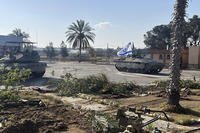The Army has high hopes for what it'll learn from its big network exercise now underway down at White Sands, N.M. About 3,800 soldiers are using the handheld devices you've read about here on Buzz, as well as the new Joint Tactical Radio System, the Mounted Soldier System, and a whole smorgasbord of other types of equipment, said Army spokesman Paul Mehney. But the service isn't just testing all this equipment to see how it works -- which it is -- the brass also want to learn as much as it can about how soldiers actually use it, Mehney said.
One of the things that has made the digital era so unpredictable, maddening and exhilarating is that when a population gets enough computers or mobile devices, users begin doing things designers either didn't intend or didn't expect. As the Army begins to make its networks more robust, and give more toys to more people across the battlefield, it isn't like fielding a new bullet or a new pair of boots. With a mobile phone or a tablet computer connected to a brigade-sized network, a soldier or a unit can theoretically collaborate in new ways, get more information from higher headquarters, and also push more information back up to commanders to help them make decisions. What the Army wants to see is how exactly all those things come together.
Mehney gave one example: Soldiers might be able to use their mobile devices to take a photo of someone they suspect could be a high-value target, then quickly send the image to an intelligence officer to confirm it's the right guy. If they've detained the wrong person, they can let him go without the need to drag him all the way back to base. Or suppose a convoy in unfamiliar territory could get a warning on their screens that they're entering an area where other units have been ambushed or hit by IEDs.
Soldiers also tell Army officials what they don't like about their high-tech toys. In an exercise last year, Mehney said, Army program officials were eager for troops to use a set of small unmanned sensors to watch remote parts of the battlefield; the sensors could take pictures of bad guys and alert commanders where they were. "But the soldiers came back and said, 'yeah, we've got this capability, but we hardly use it," he said. "We don't care about the sensors -- half the information is stagnant when we get it anyway. What we want is the ability to collaborate using this little laptop."
Troops liked the ability to get charts, operational data and other information on a networked, mobile laptop as part of the Incremental Battle Command Extension -- IBEX -- so the troops have them again at this year's exercise at White Sands.
But the Army won't always have the luxury of operating within range of commercial mobile networks, as in New Mexico. Will units have to rely on local networks, or take their own communications infrastructure into battle to be sure they can get everyone connected? The Army doesn't know yet, Mehney said. One of the things service officials are hoping to learn from the White Sands exercise is which of those directions to go -- or to prepare for both.
"It's important to note this is not an end-all activity," he said. "This is just the beginning of this process for the Army."








